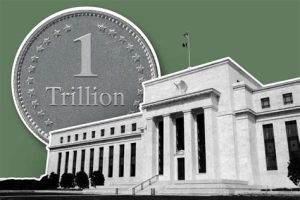The Run-Up to the Coin
The US Congress faces a partial shutdown of our government if they cannot reach an agreement to raise the debt limit by December 3. Recently, they averted disaster with an emergency spending measure using a maneuver known as a Continuing Resolution (CR).
However, this is a stopgap measure at best, because if Republicans and Democrats cannot agree to raise the debt ceiling, the amount our government can borrow to pay for spending obligations, then the federal government will run out of money to pay down debts before the end of the year. The reality is that we have been hashing and rehashing this dynamic for the last decade. And despite his promise to pay down the national debt by reining in spending, Trump not only added significant amounts of debt to our ever-growing deficit,he also suspended the debt ceiling twice in order to do so.
Yet, despite their penchant for tolerating spending under Trump, Republicans have not shown a willingness to add on to our national debt by currently raising the debt ceiling, especially as Biden and his fellow democrats push large social program packages that would significantly boost spending and call for a host of taxation increases. Now, with another debt ceiling crisis on the horizon in December, some pundits are proposing a workaround for the seemingly chronic issue that puts the divided parties into continual conflict: Just simply print a few coins.
The Trillion-Dollar Coin Solution
Well, to be precise, a few trillion-dollar coins, to pay down the debt. As Mike Bebernes of Yahoo News 360 reports, “The proposal calls for the Treasury to create one or more platinum coins valued at $1 trillion, then deposit those coins with the Federal Reserve to give the government more spending power without lifting the debt limit.”
The genesis of the trillion-dollar coin “solution” can be traced back to a commenter by the name of “Beowulf” on Cullen Roche’s blog, Pragmatic Capitalism. Beowulf cited the following clause under the 31 U.S. Code § 5112 as justification and validation for this approach: “(h) The coins issued under this title shall be legal tender… (k) The Secretary may mint and issue platinum bullion coins and proof platinum coins in accordance with such specifications, designs, varieties, quantities, denominations, and inscriptions as the Secretary, in the Secretary’s discretion, may prescribe from time to time.”

Source: money.com
Beowulf’s explanation was seemingly straightforward: “[Treasury Secretaty] Geithner could sidestep the debt ceiling this afternoon by ordering the West Point Mint to coin a 1 oz. $ 1 trillion coin. Tsy [Treasury] can then present the jumbo coins at the NY Fed to buy back $1 trillion in Fed-held debt (the Fed has to accept it, a creditor can’t refuse legal tender paid in to settle a debt).”
The Trillion-Dollar Coin: Background
As crazy as it might seem, there is a legal basis to the claim. Jack M. Balkin, Knight Professor of Constitutional Law at Yale Law School, explains it this way:
“Sovereign governments such as the United States can print new money. However, there’s a statutory limit to the amount of paper currency that can be in circulation at any one time. Ironically, there’s no similar limit on the amount of coinage. A little-known statute gives the secretary of the Treasury the authority to issue platinum coins in any denomination. So some commentators have suggested that the Treasury create two $1 trillion coins, deposit them in its account in the Federal Reserve and write checks on the proceeds.”
The Coin’s Defenders
There are several current defenders of the trillion-dollar count slight-of-hand approach. Back in 2020, in response to the widespread economic devastation caused by the Coronavirus, Congresswoman Rahisa Talib (D, MI), proposed her Automatic BOOST to Communities Act. The intention of the act was to “immediately provide a U.S. Debit Card pre-loaded with $2,000 to every person in America” and that “Each card would be recharged with $1,000 monthly until one year after the end of the Coronavirus crisis.” To pay for the program, Talib specified that it would be “funded directly from the Treasury, using its legal authority to create money via coin seigniorage, which is a statutory delegation of Congress’s constitutional power of the purse.”
Although the act was never passed, Talib revived the conversation around this controversial idea by tweeting #MintTheCoin. Economist and political commntator Paul Krugman, who has advocated for this scheme before, once again spoke out about it, arguing, “Go ahead, Democrats, and do whatever it takes to get through this. Gimmickry in the defense of sanity — and, in an important sense, democracy — is no vice.”
Similarly, Bloomberg’s Lorcan Rosche Kelly states, “Fortunately there’s an easy way to defuse this bomb. As I’ve been writing about this week, there doesn’t actually need to be a vote at all. The Secretary of the Treasury can mint a trillion dollar platinum coin, purchase $1 trillion worth of debt from the Fed, retire that debt, and then create breathing room under the debt ceiling. It sounds weird, of course, but it’s legal and it would solve the problem of a catastrophic default and potential associated recession.”
Would a Trillion-Dollar Coin Survive Challenges?
Of course, given the highly partisan atmosphere that pervades D.C. these days, there would likely be legal challenges, potentially pushing the matter all the way to the US Supreme Court. But even here it gets muddy, and the maneuver may end up surviving the challenge. As Quartz Magazine reports:
“A decision to mint the coin would likely survive legal challenges (pdf). And while such a move might be criticized as monetizing the debt, there’s little reason to believe it would be inflationary, since it is effectively an accounting trick that would not increase the amount of money in the economy. While it would represent a novel use of executive power, it would not take away lawmakers’ coveted power of the purse: The president could only spend the money lawmakers approve, and collect the revenue they allow.”
Moreover, once printed, the gears would be set in motion for the Federal Reserve to accept the coins as legal tender. As a senior correspondent for Vox Dylan Matthews points out, “ The plain text of the law clearly allows the Treasury secretary to do this, and Jay Powell, the Fed chair and in a past career an expert on the debt ceiling and its dangers, is arguably legally required to accept the coin as a deposit.”
Opposition to the Trillion-Dollar Coin
However, the trillion-dollar coin solution is not without its detractors. George Selgin of the Cato makes a fiduciary appeal: “Would relaxing the Treasury’s ‘self imposed’ rule against minting trillion-dollar coins leave us as safe, or safer, from abuse of the money power than we are now? To answer that question, one has to consider possible future consequences of the change. That means asking what might happen if the Treasury could mint not just one or two trillion-dollar coins, but as many such coins as it liked.”
Really, what’s at stake is the fact that the Fed would be saddled with a debt that has no corresponding compensatory assets to earn interest, such as bonds. As Selgin elaborates. “Once the government disburses the funds so raised, the Fed ends up with $1 trillion of liabilities on which it owes interest for each coin it has to accept, but without any additional interest-earning assets.”
Additionally, Treasury Secretary Janet Yellen doesn’t seem motivated to take the numismatic path, stating, “I believe that the only way to handle the debt ceiling is for Congress to raise it and show the world, financial markets and the public that we’re a country that will pay our bills.”
A Coinless Way Out
At the end of the day, both political parties are responsible for our current state of contentiousness regarding the debt ceiling specifically, and our national debt in general. As much as Republicans like to stand on the grounds of fiscal responsibility when Democrats are holding the purse strings, they seem anything but hesitant when they are in control. The truth is, there is simply a widening gulf of not on how much we spend as a country, but what we spend it on.
Democrats want to create a series of entitlements that serve a comprehensive social safety net, in particular for people considered to be historically marginalized. Republicans argue for lower taxes (though under Trump, no corresponding spending decreases) in conjunction with deregulatory measures that free up the market to create jobs and wealth. Both approaches have merit, and perhaps it’s time to find a way to synthesize the two seemingly disparate philosophies.
To make that happen though, Republicans will have to give up their pretensions of fiscal austerity, which they have rendered utterly hypocritical through their profligate spending. They will also need to recognize that cutting taxes alone is not a be-all and end-all solution and that many American citizens are truly struggling and might need some support to make ends meet. Turning a cold shoulder to these needs while relying on market forces will simply not put food on the table or pay the rent.
And Democrats will have to learn to prioritize the needs of the country, or they will likely never find the support they need on the other side of the aisle. Furthermore, Democrats will need to find a way to help people in a manner that empowers them to take control of their lives in a personally responsible way rather than merely relying on Uncle Sam to foot the bill, which only passes debt down the road to future generations. Additionally, they will need to recognize that new regulations and spending often create a net drag on the economy, and this onus is felt most by people at the bottom of the economic ladder, the very people they purport to help.
If the Democrats and Republicans could put aside their ideological straight jackets, we wouldn’t need to have these idiotic conversations about debt, debt limits/ceilings, or gimmicks like trillion-dollar coins. Of course, that would mean all the political posturing and grandstanding would need to stop. And given that getting reelected rather than serving the public by making difficult decisions that involve rational compromises seems to be the primary focus of our government officials, Americans shouldn’t hold their collective breath, or they will likely pass out.
At Newsweed.com, we adhere to three simple principles: truth, balance, and relatability. Our articles, podcasts, and videos strive to present content in an accurate, fair, yet compelling and timely manner. We avoid pushing personal or ideological agendas because our only agenda is creating quality content for our audience, whom we are here to serve. That is why our motto is ”Rolling with the times, straining for the truth.”
Your opinion matters. Please share your thoughts in our survey so that Newsweed can better serve you.
Charles Bukowski, the Los Angeles beat poet that captured the depravity of American urban life once said, “There is something about writing poetry that brings a man close to the cliff’s edge.” Newsweed is proud to stand in solidarity and offer you a chance to get close to the cliff’s edge with our first Power of Poetry Contest. Are you a budding bard, a versatile versifier, a rhyming regaler? Do you march to the beat of iambic pentameter, or flow like a river with free verse? If so, here’s your opportunity to put your mad poetic chops to the test. Enter our poetry contest for bragging rights and an opportunity to win some cash!






